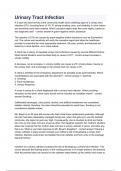Urinary Tract Infection
A5-year-old client arrives at the community health clinic exhibiting signs of a urinary tract
infection(UTI), including fever of 101 ºF, strong-smelling urine, and irritability. A urine culture
and sensitivity have been ordered. Which causative agent does the nurseexpect, based on
this diagnostictest? - correct answer-A gram-negative enteric bacterium
The majority of UTIs are caused bygram-negative enteric bacterium such as Escherichia
coli. The culture and sensitivity will verify the causative agent and allow the healthcare
provider to prescribe the most appropriate treatment.Glucose, protein, and ketones are
tested by a urinedipstick, not a urine culture.
A client has a history of repeated urinary tract infections caused by several different factors.
What clinical situation would be least likely to cause aUTI? - correct answer-Increase in
urinary motility
Adecrease, not anincrease, in urinary motility can cause a UTI. Urinarystasis, trauma to
the urinarytract, and a blockage in the urinary tract can cause a UTI.
A client is admitted to the emergency department for possible acute pyelonephritis. Which
manifestations are associated with thisdisorder? - correct answer-1. Diarrhea
2. Vomiting
3. Flank tenderness
4. Urinary frequency
A nurse is caring for a client diagnosed with a urinary tract infection. When providing
education to thisclient, which topic should not be included as a bladderirritant? - correct
answer-Smoking
Caffeinatedbeverages, citrusjuices, alcohol, and artificial sweeteners are considered
bladderirritants; therefore, the client should be educated to avoid them. Smoking is not
considered a bladder irritant.
Ms. Boyer is an82-year-old woman who had a total knee replacement yesterday. Although
her pain has been adequately managed duringrest, when she gets up to use the bedside
commode, she rates her pain very high.Consequently, she is reluctant to drink and holds
her urine so she does not have to get up often. Her daughter explains hermother's situation,
states her surprise that her mother does not have a urinary catheter inplace, and asks why
this is so. What is your best response to Ms.Boyer's daughter? - correct answer-"Having a
urinary catheter in place would increase yourmother's risk of developing a urinary tract
infection. Bacteria could enter the bladder from the catheter and from urine in the drainage
bag andtubing."
Insertion of a urinary catheter increases the risk of developing a urinary tract infection. This
occurs because the flushing action of the voiding process is no longerpresent, and bacteria
from the perineal area can ascend on the catheter sides farther up the urethra and closer to
, the bladder. Although client movement is encouragedpostoperatively, it is important to offer
the most specific response when teaching clients and family members. Referencing the
potential development of complications is very general. Insertion of a urinary catheter does
not reduce theclient's need tovoid; it may contribute to urinary retention over a prolonged
period because the bladder muscle is not contracting when a urinary catheter is in place.
Having a urinary catheter in place increases the risk forcystitis; this could ascend and
develop into a kidney infection but is a less frequent occurrence.
Ms. Rodriquez is a20-year-old woman who has had several urinary tract infections during
the past 2 years. She returned to the healthcareprovider's office for afollow-up visit and is
speaking to you regarding treatment. She tells you that she realizes that she must complete
the prescribed course of antibiotics. She is concerned that because she has taken antibiotics
several times during the past fewyears, she will develop problems. Ms. Rodriguez is asking
if there are foods that she can avoid to prevent the urinary tract infections from recurring.
What is your bestresponse? - correct answer-"you should avoid alcoholic beverages, as
consumption has been liked to increasing the risks for UTIS"
The nurse would educate the client to avoid alcoholic beverages as these have been linked
to UTIs. The client would be encouraged to drink cranberry juice and to avoid artificial
sweeteners as part of the teaching associated with decreasing the risk for UTIs.
The client asks thenurse, "How did I get this urinary tract infection(UTI)?" The nurse bases
the response on which common causativefactor? - correct answer-An ascending infection
from the urethra
The most common cause of a UTI is an ascending infection from the urethra. Congenital
strictures and urinary retention can lead toinfection, but these are not the most common
causes. Systemic infections are rarely causes of UTIs.
The client wants to know what fluids toavoid, in light of repeated urinary tract infections.
What fluids would you educate the clientabout? - correct answer-1. Citrus juices
2. Alcoholic beverages
3. Coffee
Avoiding citrusjuices, alcoholicbeverages, and coffee can help prevent urinary infections.
Increasing the intake of cranberryjuice, not avoidingit, can help prevent urinary infections.
Milk intake has no known effect in preventing urinary infections.
The nurse is caring for a client complaining of loss ofappetite, feeling confused and
lethargic, and painful urination. Based on thesesymptoms, what diagnosis does the nurse
expect? - correct answer-Cystitis
The combination ofanorexia, confusion(in theelderly), lethargy, and dysuria are symptoms
of cystitis. Symptoms are different forurethritis, pyelonephritis, and prostatitis.
The nurse is caring for a client diagnosed with a urinary tract infection(UTI). Which
assessment findings support thisdiagnosis? - correct answer-1. Flank pain
2. Burning sensation upon urination





